service indicator CHEVROLET TAHOE 2005 2.G User Guide
[x] Cancel search | Manufacturer: CHEVROLET, Model Year: 2005, Model line: TAHOE, Model: CHEVROLET TAHOE 2005 2.GPages: 536, PDF Size: 3.07 MB
Page 380 of 536
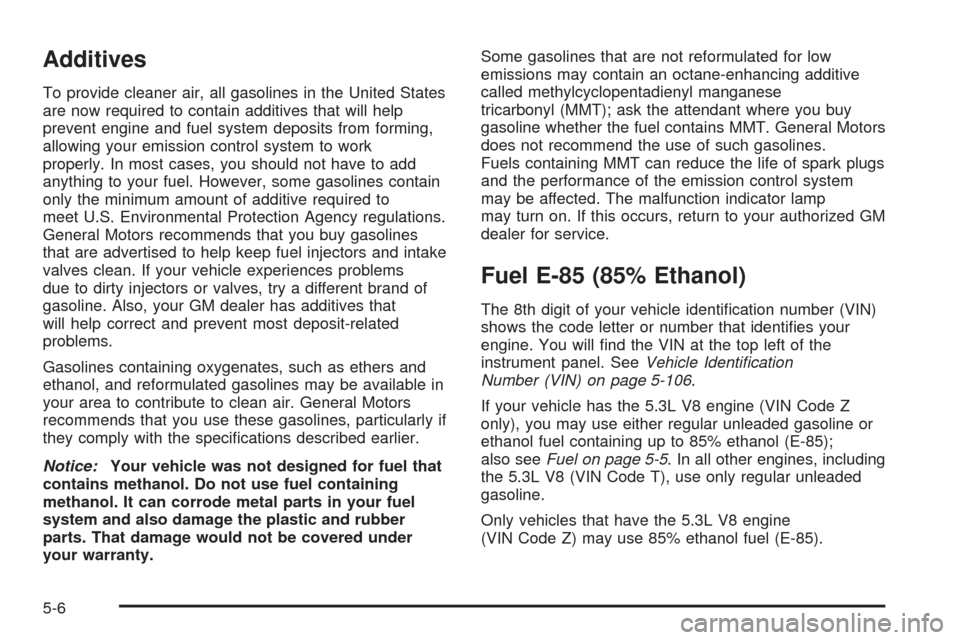
Additives
To provide cleaner air, all gasolines in the United States
are now required to contain additives that will help
prevent engine and fuel system deposits from forming,
allowing your emission control system to work
properly. In most cases, you should not have to add
anything to your fuel. However, some gasolines contain
only the minimum amount of additive required to
meet U.S. Environmental Protection Agency regulations.
General Motors recommends that you buy gasolines
that are advertised to help keep fuel injectors and intake
valves clean. If your vehicle experiences problems
due to dirty injectors or valves, try a different brand of
gasoline. Also, your GM dealer has additives that
will help correct and prevent most deposit-related
problems.
Gasolines containing oxygenates, such as ethers and
ethanol, and reformulated gasolines may be available in
your area to contribute to clean air. General Motors
recommends that you use these gasolines, particularly if
they comply with the speci�cations described earlier.
Notice:Your vehicle was not designed for fuel that
contains methanol. Do not use fuel containing
methanol. It can corrode metal parts in your fuel
system and also damage the plastic and rubber
parts. That damage would not be covered under
your warranty.Some gasolines that are not reformulated for low
emissions may contain an octane-enhancing additive
called methylcyclopentadienyl manganese
tricarbonyl (MMT); ask the attendant where you buy
gasoline whether the fuel contains MMT. General Motors
does not recommend the use of such gasolines.
Fuels containing MMT can reduce the life of spark plugs
and the performance of the emission control system
may be affected. The malfunction indicator lamp
may turn on. If this occurs, return to your authorized GM
dealer for service.
Fuel E-85 (85% Ethanol)
The 8th digit of your vehicle identi�cation number (VIN)
shows the code letter or number that identi�es your
engine. You will �nd the VIN at the top left of the
instrument panel. SeeVehicle Identi�cation
Number (VIN) on page 5-106.
If your vehicle has the 5.3L V8 engine (VIN Code Z
only), you may use either regular unleaded gasoline or
ethanol fuel containing up to 85% ethanol (E-85);
also seeFuel on page 5-5. In all other engines, including
the 5.3L V8 (VIN Code T), use only regular unleaded
gasoline.
Only vehicles that have the 5.3L V8 engine
(VIN Code Z) may use 85% ethanol fuel (E-85).
5-6
Page 414 of 536
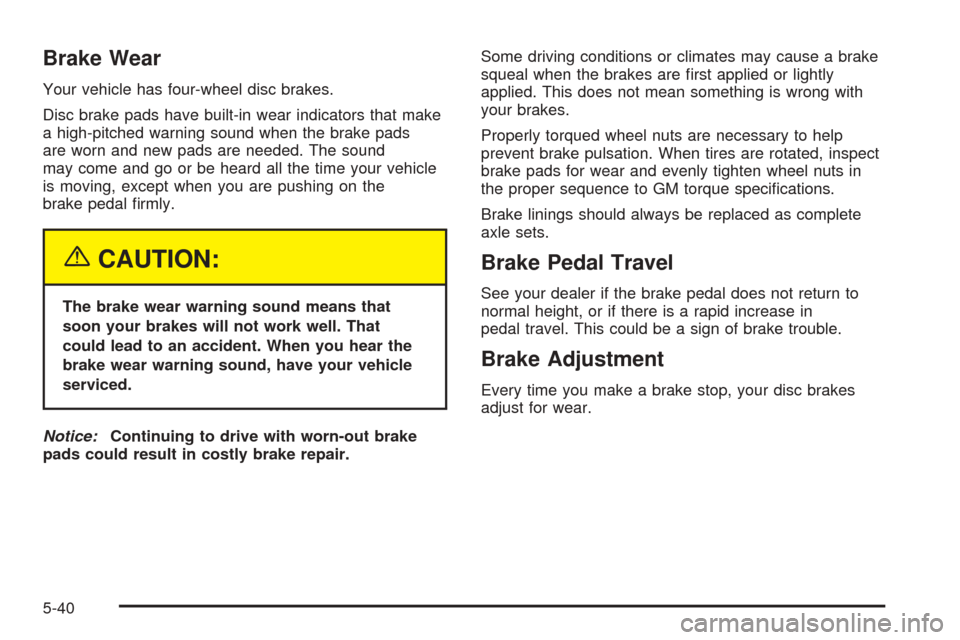
Brake Wear
Your vehicle has four-wheel disc brakes.
Disc brake pads have built-in wear indicators that make
a high-pitched warning sound when the brake pads
are worn and new pads are needed. The sound
may come and go or be heard all the time your vehicle
is moving, except when you are pushing on the
brake pedal �rmly.
{CAUTION:
The brake wear warning sound means that
soon your brakes will not work well. That
could lead to an accident. When you hear the
brake wear warning sound, have your vehicle
serviced.
Notice:Continuing to drive with worn-out brake
pads could result in costly brake repair.Some driving conditions or climates may cause a brake
squeal when the brakes are �rst applied or lightly
applied. This does not mean something is wrong with
your brakes.
Properly torqued wheel nuts are necessary to help
prevent brake pulsation. When tires are rotated, inspect
brake pads for wear and evenly tighten wheel nuts in
the proper sequence to GM torque speci�cations.
Brake linings should always be replaced as complete
axle sets.
Brake Pedal Travel
See your dealer if the brake pedal does not return to
normal height, or if there is a rapid increase in
pedal travel. This could be a sign of brake trouble.
Brake Adjustment
Every time you make a brake stop, your disc brakes
adjust for wear.
5-40
Page 497 of 536
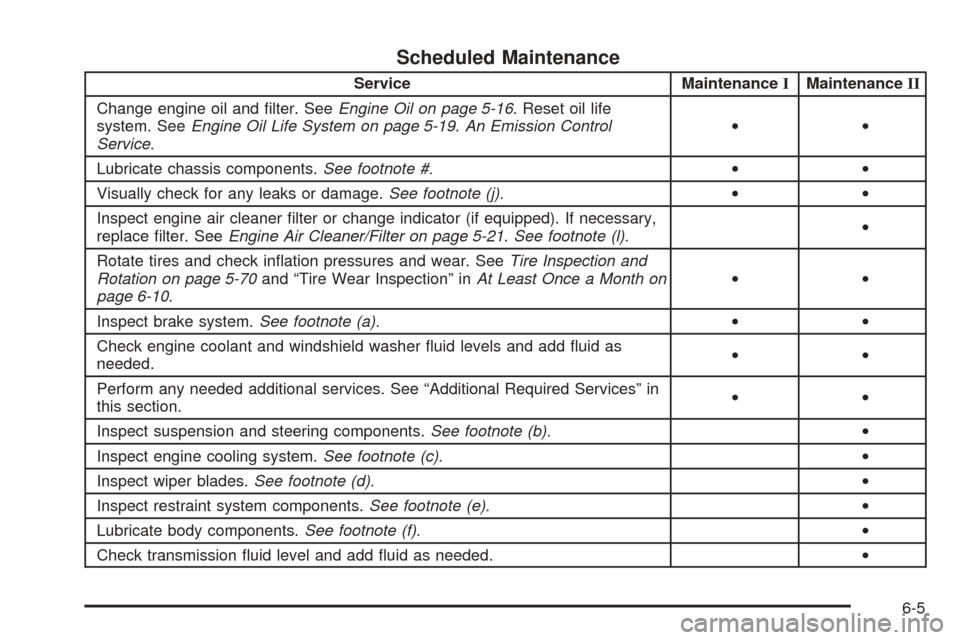
Scheduled Maintenance
Service MaintenanceIMaintenanceII
Change engine oil and �lter. SeeEngine Oil on page 5-16. Reset oil life
system. SeeEngine Oil Life System on page 5-19.An Emission Control
Service.••
Lubricate chassis components.See footnote #.••
Visually check for any leaks or damage.See footnote (j).••
Inspect engine air cleaner �lter or change indicator (if equipped). If necessary,
replace �lter. SeeEngine Air Cleaner/Filter on page 5-21.See footnote (l).•
Rotate tires and check in�ation pressures and wear. SeeTire Inspection and
Rotation on page 5-70and “Tire Wear Inspection” inAt Least Once a Month on
page 6-10.••
Inspect brake system.See footnote (a).••
Check engine coolant and windshield washer �uid levels and add �uid as
needed.••
Perform any needed additional services. See “Additional Required Services” in
this section.••
Inspect suspension and steering components.See footnote (b).•
Inspect engine cooling system.See footnote (c).•
Inspect wiper blades.See footnote (d).•
Inspect restraint system components.See footnote (e).•
Lubricate body components.See footnote (f).•
Check transmission �uid level and add �uid as needed.•
6-5
Page 498 of 536

Additional Required Services
The following services should be performed at the �rst maintenance service (IorII) after the indicated miles
(kilometers) shown for each item.
Additional Required Services
Service and Miles (Kilometers)25,000
(41 500)50,000
(83 000)75,000
(125 000)100,000
(166 000)125,000
(207 500)150,000
(240 000)
Inspect fuel system for damage or
leaks.• •••••
Inspect exhaust system for loose or
damaged components.• •••••
Vehicles without a �lter restriction
indicator: Replace engine air cleaner
�lter. SeeEngine Air Cleaner/Filter on
page 5-21.•••
Change automatic transmission �uid
and �lter (severe service).See
footnote (h).•••
Change automatic transmission �uid
and �lter (normal service).•
Four-wheel drive: Change transfer case
�uid.See footnote (g).•••
Inspect evaporative control system.An
Emission Control Service. See
footnotes † and (k).•••
6-6
Page 530 of 536
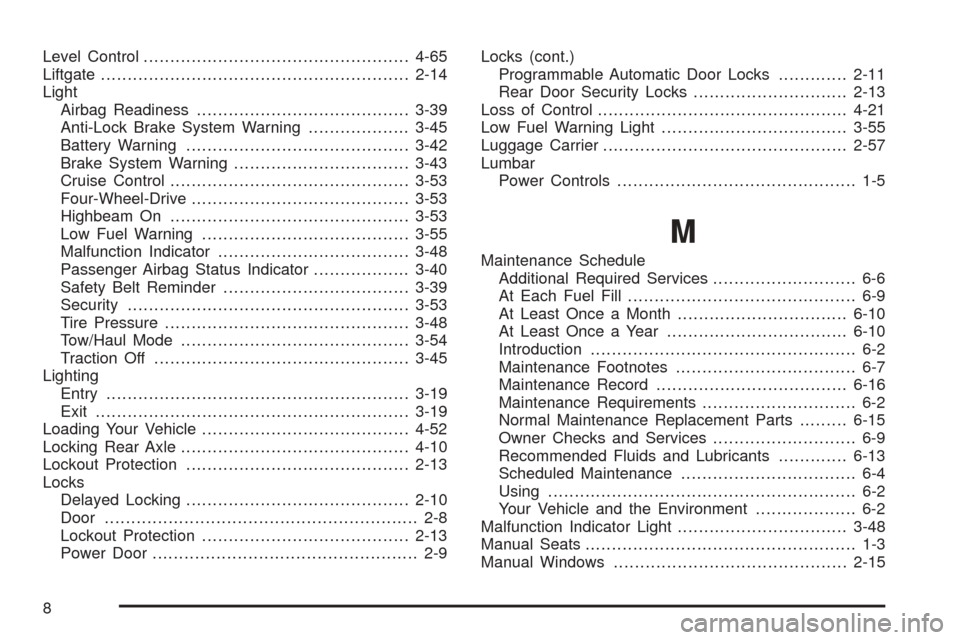
Level Control..................................................4-65
Liftgate..........................................................2-14
Light
Airbag Readiness........................................3-39
Anti-Lock Brake System Warning...................3-45
Battery Warning..........................................3-42
Brake System Warning.................................3-43
Cruise Control.............................................3-53
Four-Wheel-Drive.........................................3-53
Highbeam On.............................................3-53
Low Fuel Warning.......................................3-55
Malfunction Indicator....................................3-48
Passenger Airbag Status Indicator..................3-40
Safety Belt Reminder...................................3-39
Security.....................................................3-53
Tire Pressure..............................................3-48
Tow/Haul Mode...........................................3-54
Traction Off................................................3-45
Lighting
Entry.........................................................3-19
Exit...........................................................3-19
Loading Your Vehicle.......................................4-52
Locking Rear Axle...........................................4-10
Lockout Protection..........................................2-13
Locks
Delayed Locking..........................................2-10
Door........................................................... 2-8
Lockout Protection.......................................2-13
Power Door.................................................. 2-9Locks (cont.)
Programmable Automatic Door Locks.............2-11
Rear Door Security Locks.............................2-13
Loss of Control...............................................4-21
Low Fuel Warning Light...................................3-55
Luggage Carrier..............................................2-57
Lumbar
Power Controls............................................. 1-5
M
Maintenance Schedule
Additional Required Services........................... 6-6
At Each Fuel Fill........................................... 6-9
At Least Once a Month................................6-10
At Least Once a Year..................................6-10
Introduction.................................................. 6-2
Maintenance Footnotes.................................. 6-7
Maintenance Record....................................6-16
Maintenance Requirements............................. 6-2
Normal Maintenance Replacement Parts.........6-15
Owner Checks and Services........................... 6-9
Recommended Fluids and Lubricants.............6-13
Scheduled Maintenance................................. 6-4
Using.......................................................... 6-2
Your Vehicle and the Environment................... 6-2
Malfunction Indicator Light................................3-48
Manual Seats................................................... 1-3
Manual Windows............................................2-15
8
Page 536 of 536
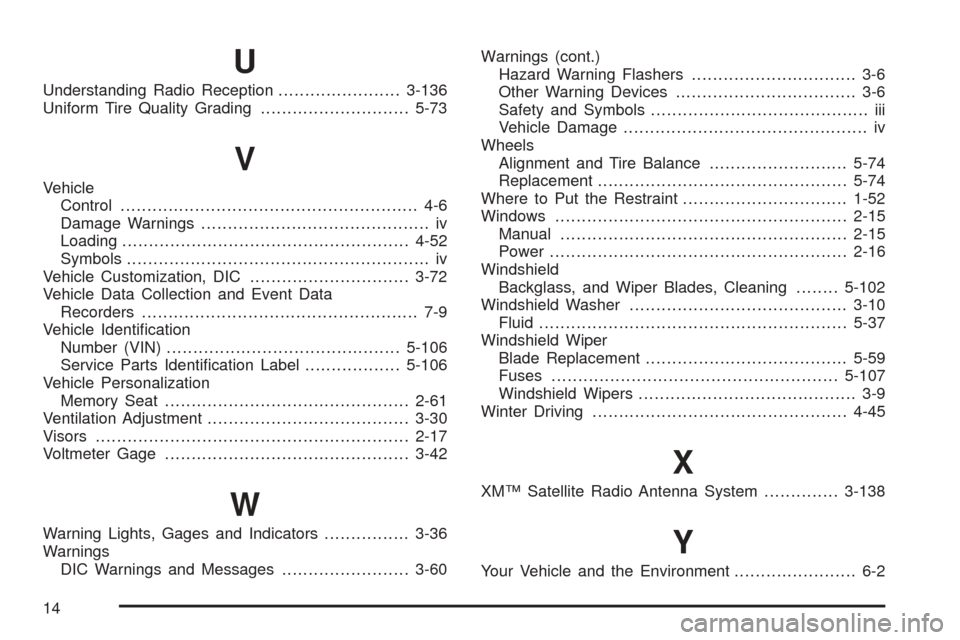
U
Understanding Radio Reception.......................3-136
Uniform Tire Quality Grading............................5-73
V
Vehicle
Control........................................................ 4-6
Damage Warnings........................................... iv
Loading......................................................4-52
Symbols......................................................... iv
Vehicle Customization, DIC..............................3-72
Vehicle Data Collection and Event Data
Recorders.................................................... 7-9
Vehicle Identi�cation
Number (VIN)............................................5-106
Service Parts Identi�cation Label..................5-106
Vehicle Personalization
Memory Seat..............................................2-61
Ventilation Adjustment......................................3-30
Visors...........................................................2-17
Voltmeter Gage..............................................3-42
W
Warning Lights, Gages and Indicators................3-36
Warnings
DIC Warnings and Messages........................3-60Warnings (cont.)
Hazard Warning Flashers............................... 3-6
Other Warning Devices.................................. 3-6
Safety and Symbols......................................... iii
Vehicle Damage.............................................. iv
Wheels
Alignment and Tire Balance..........................5-74
Replacement...............................................5-74
Where to Put the Restraint...............................1-52
Windows.......................................................2-15
Manual......................................................2-15
Power........................................................2-16
Windshield
Backglass, and Wiper Blades, Cleaning........5-102
Windshield Washer.........................................3-10
Fluid..........................................................5-37
Windshield Wiper
Blade Replacement......................................5-59
Fuses......................................................5-107
Windshield Wipers......................................... 3-9
Winter Driving................................................4-45
X
XM™ Satellite Radio Antenna System..............3-138
Y
Your Vehicle and the Environment....................... 6-2
14